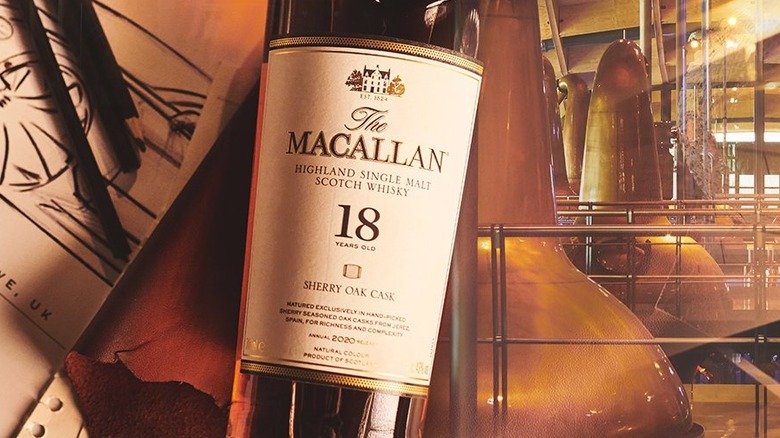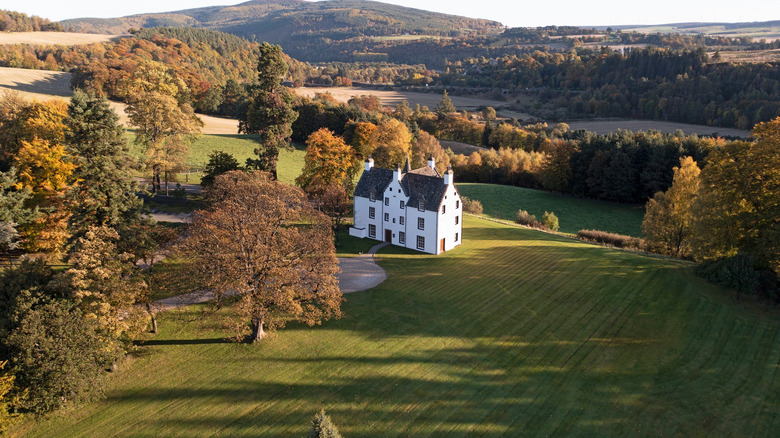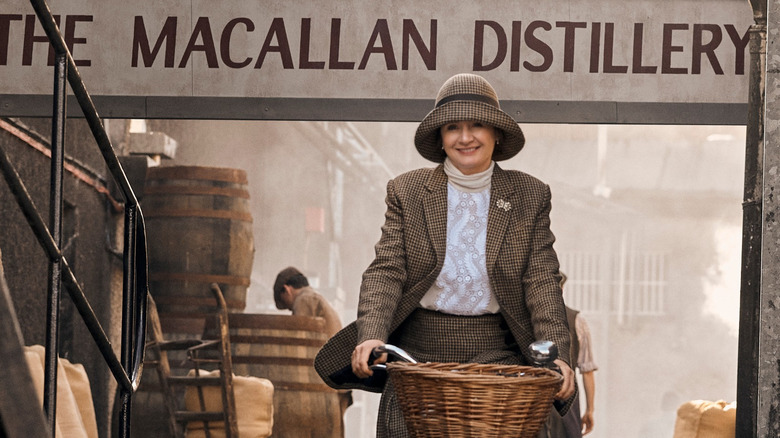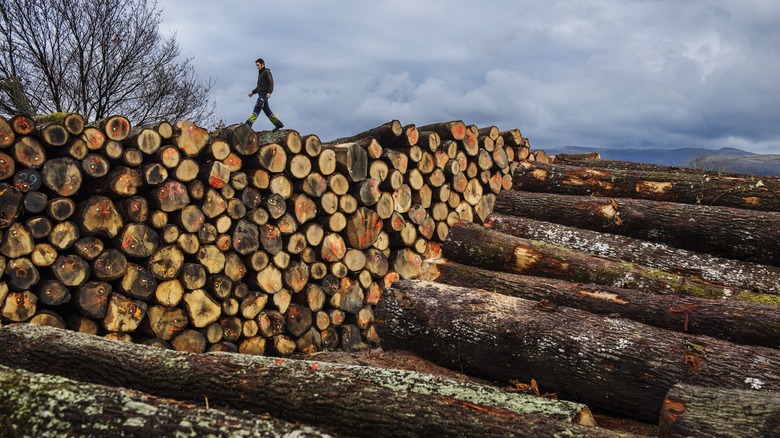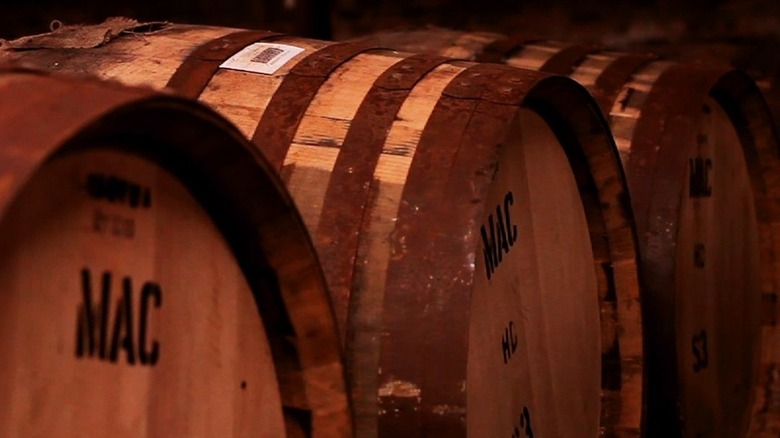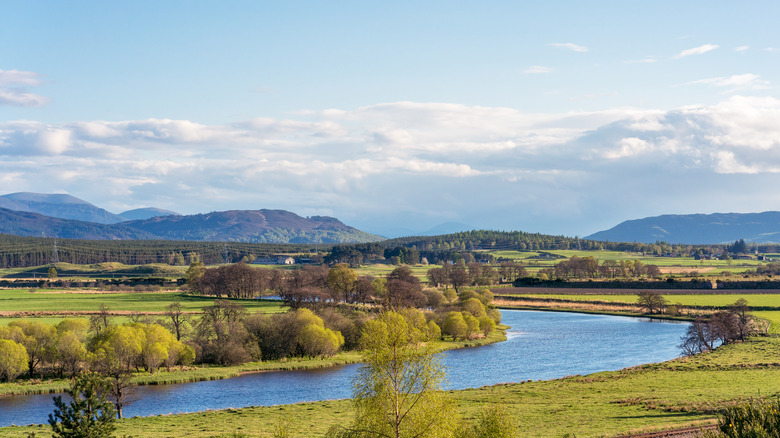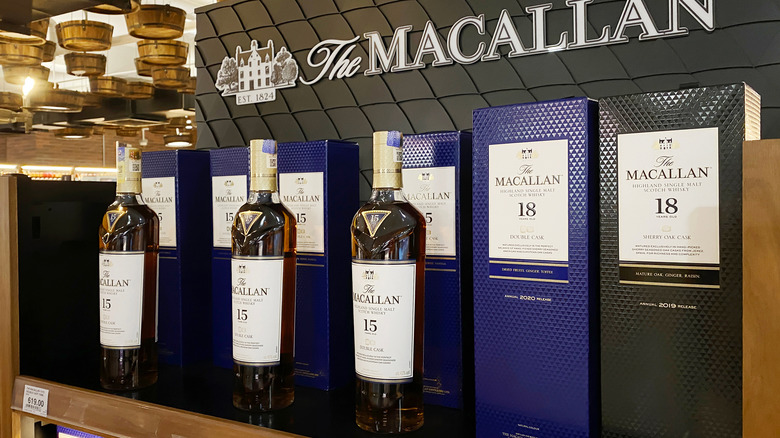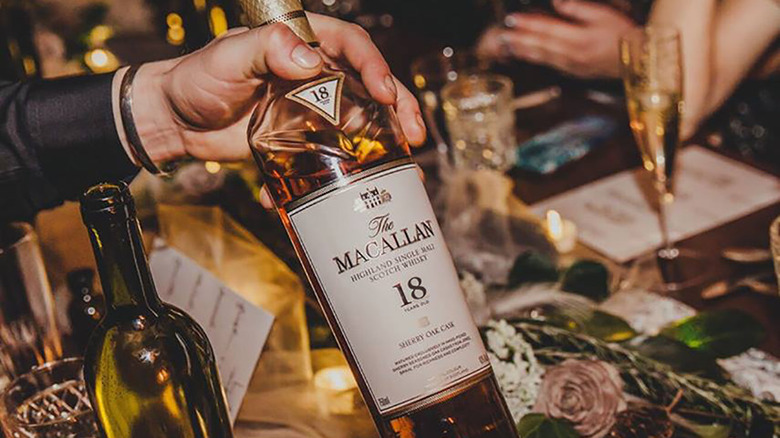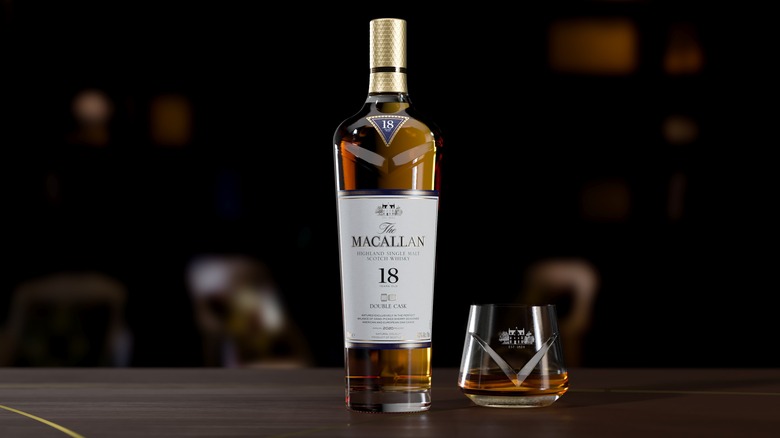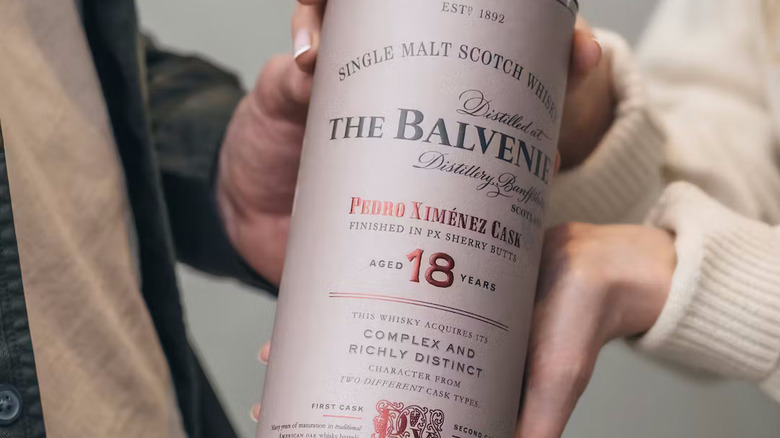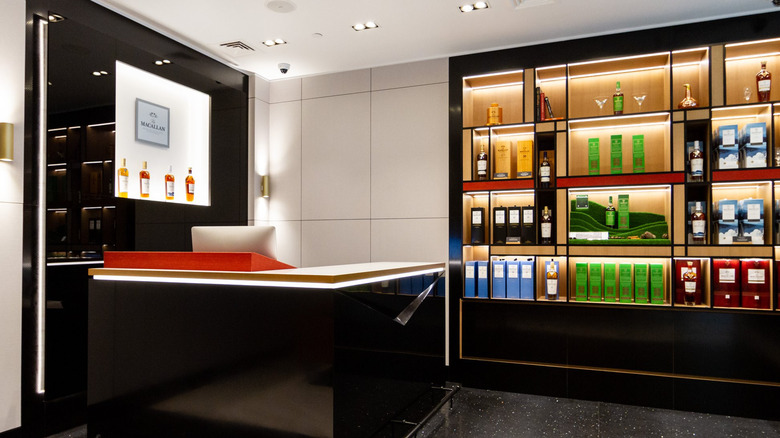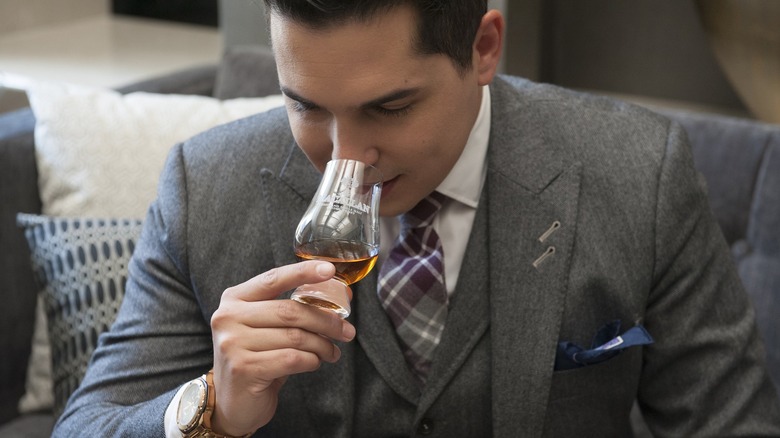The Macallan 18-Year Sherry Oak Whisky: The Ultimate Bottle Guide
The Macallan is perhaps the world's most prestigious maker of whisky, and undoubtedly one of the most popular Scotch brands. The distillery is committed to crafting exceptional single-malt whisky, and for this brand, quality will always be more important than quantity. As part of its illustrious portfolio, the 18-year-old Sherry Oak expression showcases this excellence as one of several 18-year-old Scotches it offers. While the contents may be 18 years old, the story of each bottle begins even further back through the sourcing of the wood used for barrel aging, and the distillery's rich history.
The meticulous development of its sherry-seasoned casks and the extended maturation period create a whisky with rich and complex flavors. As with many great Scotches, this whisky is a testament to the distillery's craft. With our experience of The Macallan whisky and official source material provided by the distillery, we'll explore the nuances of what makes the 18-year Sherry Oak special, and whether it's the right bottle of Scotch for you. Along the way, we'll journey through this most elegant Scottish distillery.
Founded by a schoolteacher
The captivating story of The Macallan starts with a schoolteacher by the name of Alexander Reid. Also a barley farmer, he used his mix of education and entrepreneurial spirit to make the most of the regulation of whisky distilling in Scotland following the Excise Act of 1823. From his home of Easter Elchies House, Reid built his own distillery and gave life to The Macallan brand in 1824 as one of Scotland's first licensed whisky producers. His appreciation for the local barley harvest and preference for quality ingredients immediately sent The Macallan on a path where premium taste would always be the priority.
The name Macallan is derived from the original name of the area where the whisky has been produced — "Maghellan", which comes from a combination of the Gaelic words "magh" ("fertile ground") and "Ellan", which refers to St. Fillan, who is associated with Scotland. It's an apt name, considering that the distillery draws on water from the River Spey, an iconic Scottish waterway.
While distilleries that produce all types of Scotch whisky change and evolve over the years, The Macallan is still true to the spirit of Reid. His commitment to quality and innovation played a pivotal role in shaping not only the distillery but also the industry as a whole. A distillery now known for luxury and opulence started from a humble schoolteacher's dream to make his own dram.
History of The Macallan
Alexander Reid passed away in 1847, and the distillery changed hands before it was taken over by Roderick Kemp in 1892. Kemp had plenty of experience in the industry, having previously managed Talisker, and he introduced the use of sherry-seasoned oak casks and a long maturation process in producing The Macallan. By the mid-1960s, The Macallan was primarily known as a blending whisky, but a concerted effort was launched to produce single malt whisky and distribute it around the globe. Growing from Reid's original two stills in a wooden shed, the distillery continually expanded over the years, eventually being acquired by the Edrington Group. Under Edrington, a modern new distillery was completed in 2018 to produce The Macallan, featuring 24 unique copper stills and facilities to welcome public visitors.
Today the distillery is known for its fine single malts, and appears to be leaning even more heavily into its luxury status with an expanding range of specialty and rare Scotches. While the distillery may have started in a farmhouse, its current state-of-the-art facility echoes The Macallan's commitment to innovation and excellence.
The Macallan Master of Wood
The distillery's commitment to quality craftsmanship is perhaps best shown by its employing a "Master of Wood", whose job is to oversee the production of every cask used to age The Macallan. This underscores the pivotal role that wood plays in shaping the whisky's character, with Macallan proclaiming that up to 80% of the flavor characteristics and 100% of its natural color is imparted by the oak casks. With these figures in mind, it's a surprise that more distilleries don't employ someone in such a pivotal role. The responsibilities of The Macallan Master of Wood aren't just about inspecting casks to make sure they are up to the desired quality; it goes much further than that.
The Master of Wood is responsible for choosing which trees get cut down, how they are dried, and when the logs are transported. For The Macallan, this means importing American, Spanish, and French oak for its casks. Due to the long air-drying process and the oak being seasoned with sherry, it takes approximately six years from harvesting a tree to turning it into a cask worthy of maturing single malt whisky. Whereas other distilleries will buy used casks, The Macallan takes a much more holistic approach.
How is The Macallan 18-year Sherry Oak made?
The journey of how the 18-year-old Sherry Oak makes it into a barrel begins with the careful selection of barley. Following Alexander Reid's example, the distillery still uses some barley grown at Easter Elchies estate. All barley used by The Macallan — derived from the Concerto or Momentum strains — is carefully selected for its levels of starch, potential yield, and texture. After the barley is harvested and dried, it is mashed with yeast for fermentation before being transferred for distilling.
Once distilled, The Macallan only uses a very small percentage of the spirit from the stills to utilize only the highest-quality portion. Also, while other distilleries may impart coloring at this stage to give their product more of a caramel hue, The Macallan's Scotch continues to be 100% natural. Once the spirit is ready for aging, The Macallan is very particular about the barrels it will be stored in. It's clear that The Macallan's dedication to time-tested methods, quality ingredients, and the influence of sherry-seasoned oak casks all converge in creating The Macallan Sherry Oak 18 Years Old.
Why are sherry oak barrels used?
In answering this question, it's important to note that whisky makers seldom use virgin oak for their casks. This is oak that has yet to interact with any other alcohol. Due to the long maturation process of Scotch whisky, using new casks means the chemical compounds in the oak can end up dominating the flavor. Due to their wide availability and low cost, this is why a great amount of Scotch whisky is matured in bourbon casks. However, other types of alcohol can be used to season a cask, such as rum, port, and, of course, sherry.
Many premium Scotches are aged in casks that formerly held sherry, but why is that? While in the barrel, the sherry imparts its rich tapestry of flavors into the wood. This helps to add depth and complexity to the Scotch, especially after a long maturation process. The porous nature of wood allows it to absorb a significant amount of that sherry flavor, which is then imparted to the whisky over time. The considerable cost and effort required in sourcing and preparing these barrels are why they're often used only in premium Scotch whiskies.
The hallmarks of Speyside whisky
Among the main regions of Scotland that produce Scotch, Speyside is especially renowned. Its lush landscapes are fed by the abundant freshwater sources that flow through the Highlands mountains that border the region. This plentiful supply of clear and fresh water makes it an attractive place to make whisky. This relatively small area is home to over 50 distilleries, with one being The Macallan. Each whisky region has its own characteristics, and no distillery more perfectly encapsulates what makes a great Speyside whisky than The Macallan. The best Scotches from this region are characterized by their smoothness and elegance, with a balance of sweet and floral notes.
Unlike the peated whisky of Scotland's Islay region, Speyside whiskies generally don't have much smoke on the palate, nor the medicinal characteristic of coastal Scotches. The water used in Speyside is from rivers filtered through Scotland's towering hills. By far, the most dominant of these waterways is the River Spey, hence the region's name. While not all Speyside whiskies are fed by this river, The Macallan's distillery is sited beside its banks. With The Macallan's meticulous aging process and attention to detail, its Scotch has become a perfect example of why Speyside whiskies are beloved around the world, with the likes of The Glenlivet, Glenfiddich, and Balvenie also making their whisky here. If you ever want to visit a wide range of distilleries in a short space of time, Speyside is the place to go.
A pioneer of single malt whisky
For those new to Scotch whisky, it would be logical to assume that single malts have always been regarded as the gold standard of whisky making. In reality, up until the 1980s, blended whiskies still dominated the premium Scotch market. The Macallan was one of the first distillers to switch to promoting single malts as the best of its expressions. This challenged the status quo and played a huge role in leading us to the modern day, when single malts are generally seen as the better whiskies. This move helped to elevate Scotch from being a regular alcoholic spirit to one that could be savored and enjoyed on its own.
These days, blended whiskies are often less valued as they often contain the cheaper-to-produce grain whisky. However, some great blended Scotches combine different malt whiskies with no grain whisky involved. Nevertheless, The Macallan recognized the exceptional qualities inherent in single malt whiskies, and there is a joy in their complexity that can be lost in a blend. The move to single malts was bold, mainly because it prioritized quality over quantity, and it heralded a new era for whisky production, as the distillery catered to a whole world of people who realize that alcohol isn't just a means to get drunk. It can be a way to enjoy a drink while appreciating the sources, methods, and craftsmanship that went into it.
What does The Macallan 18-year Sherry Oak taste like?
The Macallan Sherry Oak 18 Years Old is a whisky connoisseur's delight. With it being an 18-year Macallan, it has all the complexity and depth that you'll be hoping for. Firstly, the nose has a range of aromas, and we'd highly recommend using a tasting glass to pick out those delightful smells. The most distinctive notes you'll get are those of dried fruits such as figs and dates, along with orange zest and a subtle waft of cinnamon. It has everything you'd expect from a sherry-seasoned cask, and impressively balances the sweet and spicy character.
Upon the first sip, you'll be greeted by the smooth and velvety mouthfeel you'd expect from a mature whisky. The sherry influences you get on the nose transfer to the palate, but it's also joined by plenty of other flavors. The best of those is a wonderful mix of dark chocolate, ginger, raisins, and a touch of toffee. With such a premium-level scotch, you'll expect a lot from it, but the 18-year Sherry Oak delivers. The finish is long and warming, and ends with those dried fruits, subtle spiciness, and a hint of oak. Whether this will be your favorite Scotch will depend on your preference, but no doubt this is a masterfully crafted whisky befitting of The Macallan's reputation.
The Macallan 18-year Sherry Oak vs. The Macallan 18-year Double Cask
For those who love whisky matured in sherry-seasoned casks, The Macallan offers another excellent choice in the form of its 18-year Double Cask. As with the Sherry Oak, this whisky has also been matured in sherry casks, but American and European oak have been used to get the best of both worlds. In contrast, the Sherry Oak has been solely matured in European oak. The winner between these two whiskies ultimately comes down to personal preference, and which oak style you prefer.
American oak often gives a sweeter taste, which is more closely related to the notes you'll get from a great bourbon. There is a notable oak influence along with vanilla and caramel. European oak takes longer to impart its flavor, which leads to the whisky being spicier and having a greater wood influence. If you love both Scotch and bourbon, then the Double Cask may be more suited to your palate. On the other hand, if you love the earthier and more complex Scotches, you may prefer the Sherry Oak. Both are nuanced and approachable expressions that have a balanced interplay of flavors.
The Macallan 18-year Sherry Oak vs. Balvenie 18-year Pedro Ximénez Cask
If you're looking for an 18-year-old Scotch with a notable sherry influence, the Balvenie 18-year Pedro Ximénez Cask is another great option, sharing many of the same qualities as The Macallan. The road this Balvenie 18-year takes is more similar to The Macallan's Double Cask. It's first matured in American oak barrels, giving it those beautifully mellow flavors of honey and vanilla. It's then finished in Pedro Ximénez butts (a larger type of barrel) which gives it a further layer of sweet flavors along with more subtle spiciness.
Both Scotches have incredible depth, but the sherry influence of the Balvenie is more subtle. With the two being the same age, the choice between the Scotches again comes down to personal preference. The Macallan leans towards a heavier, sherry-forward experience, while the Balvenie offers a sweeter, honeyed complexity. Both expressions, however, are excellent choices for anyone looking for a complex, premium-quality whisky.
Is The Macallan 18-year Sherry Oak expensive?
Given everything you've read about this whisky, you most likely know the answer to this already. Yes, The Macallan Sherry Oak 18 Years Old is an expensive bottle of Scotch. As we've seen, the distillery's commitment to craftsmanship is a part of the reason for that. The process, which includes taking some six years from felling trees to barreling their whisky, is expensive. Due to this, when buying an 18-year-old Macallan whisky, you're getting a Scotch that has been 24 years or so in the making. The long maturation period comes with a higher price point, regardless of who is making the Scotch.
Crucially, is The Macallan 18-year Sherry Oak good value for money? We'd say both yes and no. There is no doubt this is an exceptional Scotch, and if you like whisky, you'll love it. However, there are many popular Scotch whiskies that are at least half the price and may be more suited to your tastes. We'd say the price is justified for enthusiasts who appreciate the complexity and depth, along with the distinctive sherry influence. There is a general feeling that when it comes to The Macallan, its high price tag may be intentional as part of its luxury appeal. For those interested in buying a premium-quality 18-year Scotch, there are many other cheaper options available that you may wish to explore first.
How to drink The Macallan 18-year Sherry Oak
The Macallan 18-year Sherry Oak is a distinguished single malt whisky that deserves to be savored in a way that befits its complex profile. Sipping it neat in a Glencairn glass is the expert-approved way to taste whisky for maximum flavor. Tasting glasses can be a little awkward to drink out of, but for any new whisky, they are a great way to truly appreciate both its color and smell. Drinking it this way can allow the flavors to unfold on the palate. However, this is only marginally better than drinking it in the more commonly used tumbler, so don't be afraid to drink it from your favorite glass.
Ice can be used to cool down the drink, but it's best to use ice with a smaller surface area — such as a large ice ball — to minimize dilution, or alternatively, use whisky stones. A few drops of water can help open up a whisky, but at 43% ABV (86 proof), that's not needed here. As for making cocktails, many whisky enthusiasts would tell you to avoid using such a premium Scotch, but The Macallan website suggests mixing it with sherry, lemon juice, and Cava.
Ultimately, you should drink Scotch however you want; there are no rules to follow. All we would say is that if you do use it in a cocktail, ensure all of the other ingredients are also premium quality for the ultimate taste experience.
